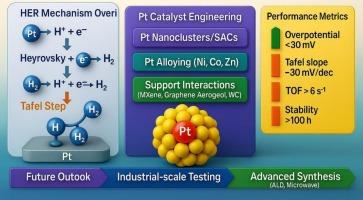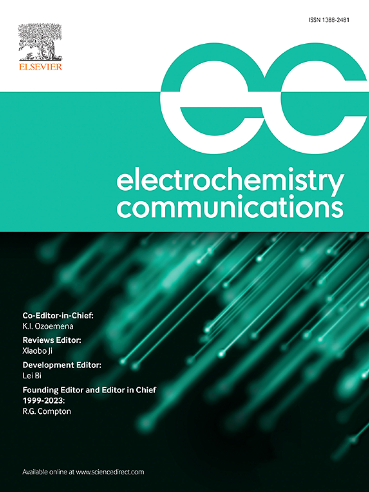酸性电解液中析氢的pt基电催化剂
IF 4.2
3区 工程技术
Q2 ELECTROCHEMISTRY
引用次数: 0
摘要
铂(Pt)基电催化剂由于其最佳的无氢吸附能(ΔGH本文章由计算机程序翻译,如有差异,请以英文原文为准。

Pt-based electrocatalyst for hydrogen evolution in acidic electrolytes
Platinum (Pt) based electrocatalysts remain the gold standard for the hydrogen evolution reaction (HER) in acidic environments due to their optimal hydrogen adsorption-free energy (ΔGH⁎ ≈ 0), high electrical conductivity, and superior chemical stability. However, the scarcity and high cost of Pt necessitate innovative strategies to reduce Pt loading while enhancing catalytic efficiency and long-term durability. This review systematically presents the recent advancements in Pt-based HER electrocatalysts, emphasizing mechanistic insights across the Volmer, Heyrovsky, and Tafel steps, and explores the influence of Pt’s electronic structure and nanostructuring on HER kinetics. Strategies such as alloying with transition metals (e.g., Ni, Co, Zn), developing single-atom catalysts (SACs), and engineering hybrid systems with supports like MXenes, graphene aerogels, and metal carbides are discussed in detail. These approaches optimize active site exposure, electronic modulation, and catalyst-support interactions to achieve high turnover frequencies, low overpotentials, and enhanced electrochemical stability under industrially relevant conditions. The review further highlights key performance indicators such as Tafel slope, mass activity, TOF, and stability, along with advanced synthesis methods, including atomic layer deposition and microwave-assisted reduction. Finally, current challenges in scalability, degradation resistance, and cost-performance trade-offs are evaluated, providing future directions toward sustainable, high-performance HER systems based on Pt. This comprehensive analysis aims to bridge the gap between fundamental catalyst design and practical hydrogen production technologies.
求助全文
通过发布文献求助,成功后即可免费获取论文全文。
去求助
来源期刊

Electrochemistry Communications
工程技术-电化学
CiteScore
8.50
自引率
3.70%
发文量
160
审稿时长
1.2 months
期刊介绍:
Electrochemistry Communications is an open access journal providing fast dissemination of short communications, full communications and mini reviews covering the whole field of electrochemistry which merit urgent publication. Short communications are limited to a maximum of 20,000 characters (including spaces) while full communications and mini reviews are limited to 25,000 characters (including spaces). Supplementary information is permitted for full communications and mini reviews but not for short communications. We aim to be the fastest journal in electrochemistry for these types of papers.
 求助内容:
求助内容: 应助结果提醒方式:
应助结果提醒方式:


